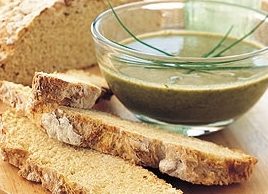Sourdough Bread
Instead of commercial yeast, delicious sourdough bread is made with a ‘starter,’ which uses the yeasts that occur naturally in the atmosphere and on flour. Despite the time needed to ‘grow’ the starter, sourdough is not a difficult bread to make.
Source: Cook Smart for a Healthy Heart, Reader’s Digest Canada

| Servings | Prep Time | Cook Time | Passive Time |
| 1large round load (20 slices) | 35minutes | 35minutes | 5-14 hours rising plus 4-6 days for the starter to develop |
| Servings | Prep Time |
| 1large round load (20 slices) | 35minutes |
| Cook Time | Passive Time |
| 35minutes | 5-14 hours rising plus 4-6 days for the starter to develop |
- Starter
- 1 cup white bread flour preferably unbleached organic flour
- 1/3 cup tepid water preferably spring water to “feed”
- 2-3 cups white bread flour preferably unbleached organic flour
- tepid water preferably spring water
- Dough
- 5 cups white bread flour preferably unbleached organic flour
- 1 tsp salt
- 1 cup tepid water preferably spring water, or as needed
|
Ingredients
Servings: large round load (20 slices)
Units:
|
- To make the starter, place the flour and tepid water in a bowl and stir together to make a sticky paste. Cover with a damp dish towel (not plastic wrap) and leave on the kitchen counter for 2 days, dampening the dish towel again as needed to keep it moist. If after 2 days the mixture looks bubbly and has a milky smell, you can proceed to the first “feed.” (It may take up to 4 days to reach this stage.) If there are patches of mould or the paste smells sour or bad, throw it away and begin again with a new batch of starter.
- To “feed” the starter, stir 1 cup flour and enough tepid water into the starter to make a soft, paste-like dough. Cover the bowl as before and leave for 24 hours. At this point the starter will look very active and bubbly. Stir well, then discard half the starter. Stir another 1 cup flour and enough tepid water into the starter to make a soft, paste-like dough. Cover again and leave for 12 hours. If the starter looks very bubbly and lively, it is ready to use. If it seems only slightly bubbly, give it one more feed of 1 cup flour and tepid water and wait 6 hours.
- To make the dough, place the flour and salt in a large bowl. Mix together and make a well in the centre. Transfer 2 cups of the starter into a separate bowl and mix it with the tepid water, then pour it into the well in the flour. Gradually work the flour into the liquid mixture to make a soft dough. You may need to add a little more water as you work if the dough feels dry or crumbly, or more flour if it sticks to your hands or the bowl.
- Turn the dough out onto a floured work surface and knead for about 10 minutes or until very pliable. Return it to the cleaned bowl, cover with a damp dish towel and leave to rise in a warm place for 3–8 hours or until doubled in size. Rising time depends on the room temperature and on the strength of your starter. (A new starter will give a slower rise and less volume than one that is well established.)
- Turn out the risen dough onto a floured work surface and knock it back with your knuckles to its original size. Shape the dough into a ball and set it in a basket or colander lined with a heavily floured linen dish towel. Cover with a damp dish towel and leave to rise for 2–6 hours or until doubled in size.
- Toward the end of the rising time, preheat the oven to 425ºF (220ºC). Invert the dough onto a large greased baking sheet and make a single slash across the top of the loaf with a sharp knife. Bake for about 35 minutes or until the bread sounds hollow when removed from the sheet and tapped on the base.
- Transfer the bread to a wire rack and leave to cool. Sourdough bread can be kept for up to 5 days, and is wonderful toasted.
Sourdough bread variations: Leftover sourdough starter can be stored in an airtight container in the refrigerator. Before using it to make another loaf, bring it back to room temperature, then feed it once as in the main recipe and leave for about 6 hours. Each time you make a loaf, you will have leftover starter. This can be kept in the refrigerator, provided you feed it every 4 days to keep it alive. It will improve in flavour with time. Any starter you do not need or want can be discarded, or given to a friend. • Instead of spring water, you can use water that has been filtered, boiled and cooled. • To make a French-style sourdough bread, replace 1⁄2 cup white bread flour with 5 1⁄2 tablespoons whole-wheat bread flour. • To make a heavier, German-style sourdough bread, replace half the white bread flour with rye flour.
Per slice: 113 calories, 4 g protein, 0.4 g total fat, 0.1 g saturated fat, 0 mg cholesterol, 23 g total carbohydrate, 0.1 g sugars, 1 g fibre, 122 mg sodium
Sourdough starters can last for decades, and seem to be resistant to contamination. This may be due to an antibiotic action similar to that of the moulds in cheeses such as Stilton and Roquefort.




